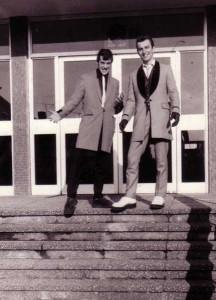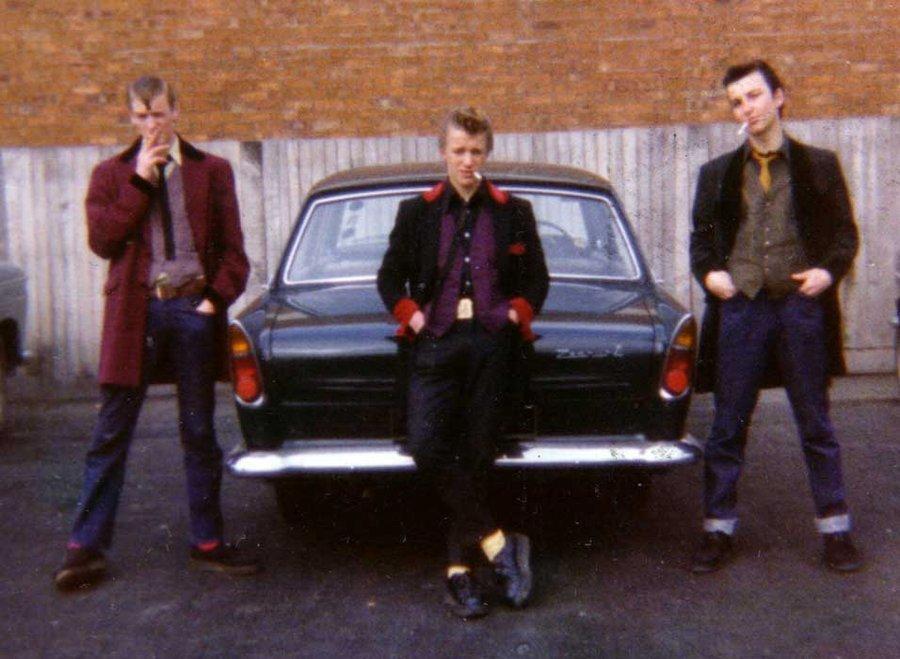Teddy Boys - Teddyboys are representatives of the youth subculture of the 1950s.
Contents:
What is Teddy Boy
Sissy; Teddy; Ted: noun;
Member of a youth cult of the mid-to-late 1950s, characterized by a dress style inspired by the fashions of the Edwardian era (1901–10). Edward is shortened to Teddy and Ted.
The Teddy boys called themselves Teds.
— Definition of Teddy Boy from The Concise New Partridge Dictionary of Slang and Unconventional English

Teddy Boys 1950s
Teddy fights date back to the late 1940s and early 1950s when, after the war, a generation of young people who had money to burn appropriated the Edwardian (teddy) dress style currently in vogue on Saville Row, and took him up a notch. In the beginning there were draperies and trumpet pants. This appearance was then changed; draperies trimmed at collar, cuffs, and pockets, still tighter trousers, crepe-soled shoes or beetle-crushers, and a hairdo heavily oiled into bangs and shaped like DA, or, as it was popularly called, duck-ass because it resembled one. It is widely acknowledged that in the UK the Teddy Boys were the first group to have their own style.
The Teddy Boys were the first truly famous rebellious teenagers who flaunted their clothes and behavior as a badge. Therefore, it is not surprising that the media were quick to portray them as dangerous and violent based on one incident. When teenager John Beckley was murdered in July 1953 by the Teddy Boys, the Daily Mirror headline "Flick Knives, Dance Music and Edwardian Suits" linked crime to clothing. Further stories of teenage abuse followed, ominously reported and no doubt exaggerated in the press.
In June 1955, the headline of the Sunday Dispatch was typically sensationalist tabloid style, headlined as follows:
"WAR ON THE TEDDY BOYS - The threat on the streets of British cities is finally eliminated"

Teddy boys (and girls) are considered the spiritual ancestors of both mods and rockers.
Second generation Teddy Boys; Revival of the Teddy Boys 1970s
In fact, the Teds were never more than a minority in their age group, but they were the first to see themselves and society saw them as teenagers, bad boys and thus a separate group. They also appeared earlier, but became associated with rock and roll, which, of course, in itself became fresh fodder for the media, offering more stories about sex, drugs and violence. Twenty-five years later, the 1977 Teddy Boys line never died out and there was a resurgence due to a resurgence of interest in rock and roll as well as a resurgence of interest in Teddy Boy fashion. The look was promoted by Vivienne Westwood and Malcolm McLaren through their Let it Rock store on London's Kings Road. This new generation of Teds took on some aspects of the 1950s but with more glam rock influences, including brighter colors for draped jackets, brothel creepers and socks, and shiny satin shirts worn with drawstring ties, jeans and belts with large buckles. In addition, they used hairspray more often than styling oil.
Basically, the Teddy Boys were rigidly conservative and traditional, and being a Teddy Boy, they were often part of the family. An important difference between the Teddy Boys of the 1950s and the Teddy Boys of the 1970s was that while the clothing and music may have remained the same, violence was more prevalent.
Teddy Boys and Punks
How did the Teddy Boys encounter the Punks?
When you look at the two youth groups, you will see that this was inevitable. In 1977, these New Teddy Boys were younger and eager to make a name for themselves. What better way to prove your youth and the fact that they are still alive than the old way of finding a more famous enemy and beating him to a pulp? First mods and rockers; now Teddy Boys and Punks.
Good old jealousy was another reason to clash with punks. The media covered the punks extensively as a new gang in town. In the 70s, Teddy Boys experienced a huge resurgence among young people, but never received much press coverage and very little radio coverage. The famous Teddy Boys march in London, when thousands of Teddy Boys marched to the BBC from all over the UK demanding the BBC play some real rock and roll. On the contrary, if everything that the punks do got on the front pages of the newspapers. Violence meant more publicity and a higher profile for the Teddy Boy, which meant more teenagers were attracted to becoming Teddy Boys.
The irony of all this was that despite their differences, the Teddy Boys and Punks had a lot in common. Both were devoted to their music and clothing, which identified as separate from society, which they considered boring and ordinary. Both have been vilified and demonized in the press as teenagers full of destruction and relationships and a threat to society.
Teddy Boys in the 80s, 90s and 2000s
In the late 1980s, some Teddy Boys made an attempt to recreate the original Teddy Boy style of the 1950s. This led to the formation of a group known as the Edwardian Drapery Society (TEDS) in the early 1990s. At the time, TEDS were based in the Tottenham area of north London and the band focused on restoring a style they felt had been tainted by pop/glam rock bands. In 2007, the Edwardian Teddy Boys Association was formed to continue the work of restoring the original style and working to bring together all drapery plush boys who want to emulate the original 1950s style. Most Teddy Boys now wear much more conservative Edwardian uniforms than those worn in the 1970s, and this more authentic dress code emulates the original 1950s look.
Edwardian Teddy Boy Association website
Leave a Reply